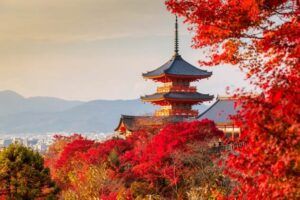Experience the Timeless Tradition of Hatsumode: A New Year’s Pilgrimage in Japan

One of the most unique and enriching aspects of traveling to Japan is experiencing centuries-old traditions that have been passed down through generations. Among these, Hatsumode, the first shrine or temple visit of the New Year, is a profound and culturally immersive experience that we invite you to explore during your journey to Japan.
What is Hatsumode?
Hatsumode is a New Year’s tradition in Japan where individuals and families visit a Shinto shrine or Buddhist temple to pray for health, happiness, and prosperity in the year ahead. It’s a time to reflect on the past year, give thanks, and make wishes for the future.
In Japan, the coexistence of Buddhism and Shintoism has created a unique cultural blend, allowing visitors to choose between shrines or temples for their Hatsumode experience. The choice is yours!
At shrines, the traditional method of praying involves the “two bows, two claps, one bow” ritual.
At temples, visitors simply bow and quietly bring their hands together in prayer, refraining from clapping.
When Should You Go for Hatsumode?
The timing for Hatsumode can vary, but these three periods are the most common:
- New Year’s Day (January 1st): Many people aim to visit on the very first day of the year for good luck.
- The First Three Days (January 1st–3rd): Known as the “Sanganichi,” this is the most popular period for Hatsumode.
- The First Week (January 1st–7th): This extended period, often referred to as “Matsu no Uchi,” allows visitors to avoid the heavy crowds of New Year’s Day.
Customs to Observe During Hatsumode
- Bring Old Talismans and Charms: If you have received any protective amulets or lucky charms (such as omamori) during the previous year, it’s customary to return them to the shrine or temple during Hatsumode. They will be purified and respectfully burned in a ceremonial fire.
- Receive New Lucky Charms: While at the shrine or temple, don’t forget to pick up new talismans, amulets, or other symbolic items like ema (wooden plaques) or hamaya (decorative arrows) for good fortune.

Fun Traditions to Enjoy
- Ema (Wooden Plaques): Write your wishes for the year and hang them at the shrine or temple.
- Omikuji (Fortune Slips): Draw your fortune for the year! If you receive a good fortune, you can keep it with you. If it’s not so favorable, tie it to a designated area at the shrine or temple to leave the bad luck behind.
- Hamaya (Decorative Arrows): These are taken home and displayed to ward off evil and invite blessings.

Why Experience Hatsumode During Your Trip to Japan?
Hatsumode is not just about making wishes; it’s about connecting with Japan’s spiritual and cultural heritage. The vibrant atmosphere of bustling shrines and temples, the aroma of traditional festival foods from street vendors, and the joy of starting a new year in the spirit of hope and renewal create a truly memorable experience.
By participating in Hatsumode, you’ll gain insight into Japanese traditions, witness the country’s deep-rooted spirituality, and become part of a timeless ritual that has united people for centuries.
Make Hatsumode a Highlight of Your Japan Adventure
This New Year, why not embark on a journey that combines travel, tradition, and tranquility? Whether it’s visiting the iconic Meiji Shrine in Tokyo, the historic Fushimi Inari Shrine in Kyoto, or a local temple in a quaint countryside town, Hatsumode is an experience that will deepen your appreciation for Japanese culture.
Start your year with a heartfelt prayer and immerse yourself in the timeless beauty of Japan’s traditions. Let’s celebrate the New Year the Japanese way!











